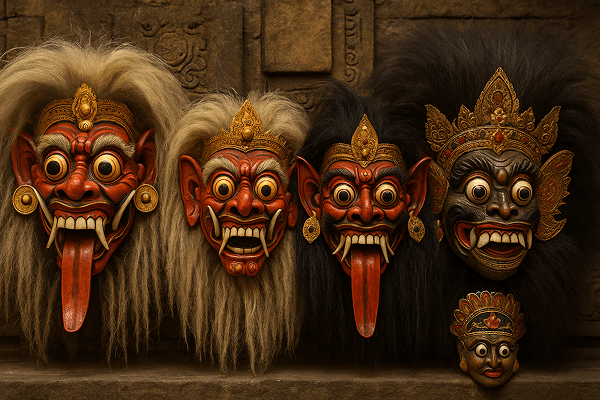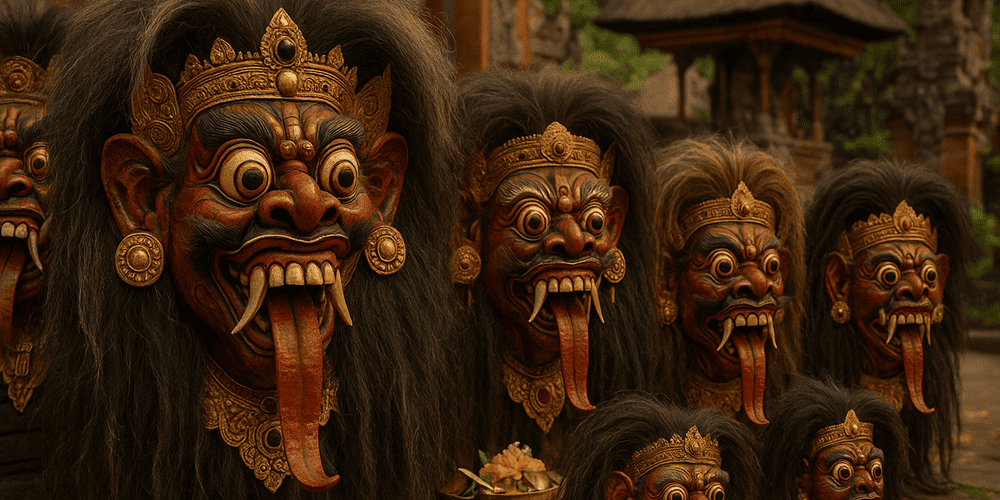Rangda Masks are among the most iconic and dramatic ceremonial masks in Indonesian, and especially Balinese, culture. Instantly recognizable for their terrifying appearance, Rangda Masks feature bulging eyes, protruding fangs, wild hair, and long, lolling tongues. These grotesque yet captivating features are designed to evoke both fear and respect. Rangda, the “Queen of the Leyaks,” is the primary antagonist in Balinese mythology and is often depicted as a powerful witch with immense supernatural abilities. The use of Rangda Masks is deeply rooted in the spiritual and artistic traditions of Bali, dating back to at least the 11th century, and remains central to ritual and theatrical performances today.
Historical Origins: The Evolution of Rangda Masks
The history of Rangda Masks is closely linked to the evolution of Balinese Hinduism and local mythology. The term “Rangda” means “widow” in Old Javanese, reflecting the character’s origins as a powerful and often vengeful female spirit. The legend of Rangda is thought to be inspired by historical figures, including the infamous queen Mahendradatta, who was exiled and became a symbol of dark magic and chaos in Balinese folklore. Over centuries, the design and use of Rangda Masks evolved, absorbing influences from Javanese wayang (shadow puppetry) and Hindu iconography. Historical records, temple carvings, and ancient manuscripts all reference Rangda and her battles with Barong, the lion-like spirit of good. The interplay between Rangda Masks and Barong Masks forms the foundation of Balinese dance-drama, symbolizing the eternal struggle between good and evil.
Cultural Significance and Symbolism: The Power of Rangda Masks
In Balinese culture, the Rangda Mask is much more than a theatrical prop — it is a potent symbol of destructive power, transformation, and spiritual danger. Rangda represents chaos, illness, and death, but also the necessity of confronting and ultimately balancing these forces within the community. The mask’s exaggerated features are designed to frighten away evil spirits and serve as a reminder of the dangers posed by uncontrolled negative forces. Ritual performances featuring Rangda Masks are believed to provide spiritual cleansing, protect communities, and maintain cosmic harmony. Myths and legends surrounding Rangda emphasize her battles with Barong, her magical prowess, and her role as a test that the community must face and overcome. The social context of Rangda Mask performances is communal and sacred, with villagers gathering for temple festivals, purification ceremonies, and rites of passage.
Materials and Craftsmanship: Creating Authentic Rangda Masks
Traditional Rangda Masks are masterfully carved from lightweight wood, such as pule or hibiscus, which is believed to possess spiritual properties. The carving process begins with drawing the basic design, followed by intricate sculpting to bring out the menacing facial features. Artisans use specialized chisels, knives, and sanding tools to achieve the desired detail. Once carved, the mask is painted with vivid colors — typically red, black, and gold — and adorned with natural materials such as horsehair, real teeth, and fabric for the tongue and hair. Decorative motifs are often symbolic, representing flames, magical patterns, or protective mantras. Regional differences in craftsmanship are evident: masks from different parts of Bali may vary in size, style, and ornamentation. The color red typically symbolizes power and danger, while gold represents divinity and protection.
Functions and Use: Ritual and Theatrical Applications of Rangda Masks
Rangda Masks are primarily used in ritual and ceremonial contexts, especially in the Barong and Rangda dance-drama performed at temple festivals and important communal events. The mask is worn by a trained performer who, through dance and trance, embodies the spirit of Rangda and enacts her legendary confrontations with Barong. These performances are seen as essential for spiritual cleansing, exorcism, and the restoration of balance in the community. Over time, Rangda Masks have also been featured in secular theater, parades, and cultural exhibitions, expanding their role beyond strictly religious use. Today, Rangda Masks continue to inspire contemporary Balinese artists and remain a powerful symbol in both ritual and popular culture. For those interested in the broader context of Balinese masking traditions, Barong Masks provide a fascinating counterpart to the Rangda Mask.
Regional Variations: Diversity of Rangda Masks in Indonesia
While the Rangda Mask is primarily associated with Bali, there are regional variations in its form and function across the Indonesian archipelago. In different Balinese villages, Rangda Masks may display unique features, such as additional ornamentation, variations in hair length, or distinct facial expressions. Some regions emphasize more grotesque features to heighten dramatic effect, while others incorporate local myths and symbols into the mask’s design. Comparisons with similar masks in neighboring cultures, such as the Javanese Reog or the Thai Khon masks, highlight both the uniqueness and the syncretism of Indonesian mask traditions.

Famous Examples and Collections: Where to See Rangda Masks
Notable examples of Rangda Masks are preserved in leading museums, such as the Bali Museum in Denpasar, the Agung Rai Museum of Art, and the Indonesian National Museum in Jakarta. These institutions showcase antique and contemporary Rangda Masks, along with costumes, musical instruments, and ritual paraphernalia. Private collections and art galleries in Bali and abroad often feature rare and historically significant masks, some used in actual ceremonies. For those wishing to study or collect Rangda Masks, online resources like toddmasks.com provide curated selections and detailed educational materials.
Influence on Art and Culture: Rangda Masks in Modern Creativity
The influence of Rangda Masks extends far beyond ritual performance. Their bold, expressive forms have inspired generations of Balinese painters, sculptors, and contemporary artists. Rangda Masks frequently appear in literature, film, and music, serving as powerful symbols of mystery, danger, and transformation. In modern fashion and design, Rangda motifs are used to evoke Balinese heritage and dramatic flair. The enduring popularity of Rangda Masks plays a vital role in preserving Balinese cultural identity, contributing to Bali’s global reputation as a center of artistic innovation and spiritual tradition.
Modern Status and Preservation: Ensuring the Future of Rangda Masks
The tradition of Rangda Mask-making is maintained by master craftsmen, cultural institutions, and temple communities throughout Bali. Apprenticeships, workshops, and festivals help transmit traditional techniques to new generations, while also encouraging creative innovation. Modern adaptations include the use of new materials and integration with digital media, but authentic craftsmanship remains the standard for sacred and ceremonial masks. Educational initiatives, museum exhibitions, and cultural tourism play crucial roles in preserving the knowledge and appreciation of Rangda Masks for future generations.
Collecting and Acquisition: The Market for Rangda Masks
The market for Rangda Masks includes both genuine ceremonial pieces and high-quality reproductions intended for collectors and art enthusiasts. Authentic masks can be found in Balinese art markets, temple shops, museum stores, and curated online galleries like toddmasks.com. Prices vary widely depending on the age, provenance, craftsmanship, and ritual significance of each mask. When collecting, it is important to verify authenticity, respect the cultural and spiritual context, and support ethical sourcing that benefits local artisans and communities.
